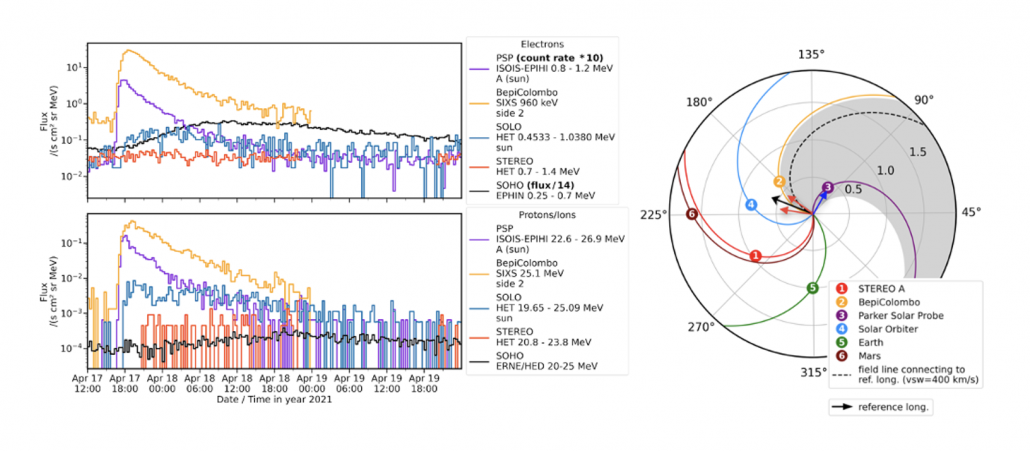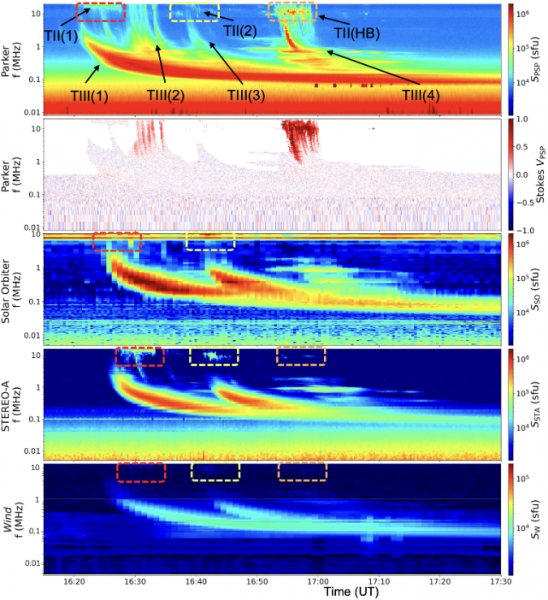A long-standing problem in solar energetic particle (SEP) studies is to pinpoint their source regions at the Sun. Potential contributions by both the flare and CME-driven shocks complicate the analysis. A certain type of SEP events shows very wide particle spreads up to all around the Sun. The mechanisms proposed so far to generate these widespread events are a very wide SEP injection region, likely a shock, or strong perpendicular diffusion in the interplanetary medium (e.g., Dresing et al. 2014). Our exhaustive multi-spacecraft analysis of the 17 April 2021 widespread SEP event revealed a new potential driver for widespread events, that is multiple distinct SEP injections at the Sun, which head into significantly different directions. Multi-spacecraft radio observations were key in discovering this new scenario.

Figure 1: Right: Longitudinal spacecraft constellation and magnetic connectivity at 16:00 UT on 17 April 2021. The spiral lines represent magnetic field lines connecting the spacecraft to the Sun (colored solid) and the flare site to the heliosphere (black dashed). The black arrow marks the longitude of the flare, red and blue arrows show the directions of different distinct SEP injection episodes as determined from radio bursts analyses. (Figure produced with Solar-MACH (Gieseler et al. 2023)). Left: Multi-spacecraft SEP observations of ∼1 MeV electrons (top) and ∼25 MeV protons (bottom) observed by the spacecraft indicated by the same colors in the right figure.
Fig. 1 (left) shows SEP observations by five different observer positions in the inner heliosphere, who detect the event: Solar Orbiter (SolO), Parker Solar Probe (PSP), STEREO A, SOHO and Wind near Earth, and BepiColombo. Fig. 1 right shows the corresponding spacecraft constellation.
Fig. 2 shows radio spectrograms observed by PSP, SolO, STEREO A, and Wind. PSP (top) observes the most complex radio signal with four distinct type III burst groups (TIII) and three type II burst episodes (TII), all together lasting over a period of 40 minutes. While TIII(1) and TIII(3) are observed by all spacecraft, TIII(2) and TIII(4) are only seen by PSP, suggesting that these propagate into different directions than the other bursts. This is further supported by their strong polarization (2nd panel of Fig. 2), which suggests that these propagate towards the PSP spacecraft, indicated by the blue arrow in Fig. 1 (right). For TIII(1) and TIII(3) we performed a radio propagation analysis using the multi-spacecraft radio observations. The resulting propagation directions are marked by the two red arrows in Fig. 1 (right). All together, a longitudinal range of 110° is spanned by the different injection directions, marked by the gray shaded area.

Figure 2: Radio spectrograms from all available space-borne observatories of the 17 April 2021 event. From top to bottom panels 1 and 2 show Stokes I and the net polarization (Stokes V/I) from PSP. Panels 3–5 show the Stokes I measurements from SolO, STEREO A, and Wind, respectively. The different bursts are indicated in panel 1. The type II (TII) bursts are marked in other panels by rectangular boxes of red, yellow, and orange.
We conclude that distinct SEP injections into significantly different longitudinal directions, which were all related with the same solar activity, play a major role in producing the widespread SEP observations of the 17 April 2021 event. However, perpendicular diffusion, and potentially also the shock, likely contributed as well.
Based on the recent paper by Dresing, N., Rodríguez-García, L., Jebaraj, I. C., Warmuth, A., Wallace, S., Balmaceda, L. et al., The 17 April 2021 widespread solar energetic particle event, A&A, 674, A105: 2023, doi:10.1051/0004-6361/202345938
References
Dresing, N., Gómez-Herrero, R., Heber, B. et al. 2014, A&A, 567, A27
Gieseler, J., Dresing, N., Palmroos, et al. 2023., FrASS, 9, 384
